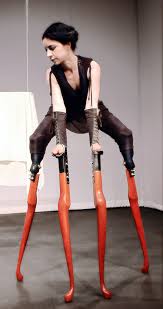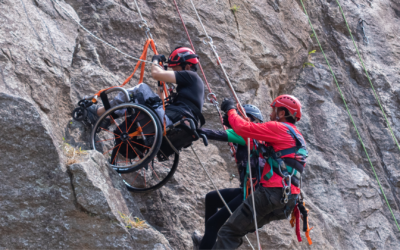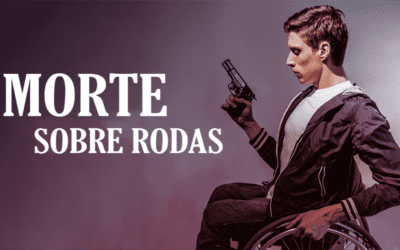
The art of disability on display at Bodies of Work
If the Bodies of Work Festival succeeds in its mission, the arts community in Chicago will start thinking about artists and audiences with disabilities. Not think of them in a whole new way. Just be aware of their existence.
“We want to get people to think about disability not as some problem to be solved but as different needs to be explored,” says Carrie Sandahl, the director of the festival and a professor in the department of disability and human development at the University of Illinois-Chicago. “Most people don’t think much about disability beyond the stereotypes.”
One of the worst stereotypes about art by disabled artists is that it’s amateur work—created as therapy, displayed as an act of kindness, and worthy, at best, of the label “outsider art.” And though the Bodies of Work organization does encourage the work of young and emerging artists in various events it hosts throughout the year, the first major decision Sandahl made in creating this year’s festival was to showcase only the work of professional artists.
The first Bodies of Work Festival was in 2006, but it’s been on hiatus since then. “No one was willing to take leadership,” Sandahl explains, “and people don’t fund festivals.” Sandahl took over as the head of Bodies of Work in 2010 and spent several years, as she puts it, building a track record of events in order to gain experience and attract funding. Now, thanks to small grants and volunteers, the Bodies of Work Festival is launching again.
“We want people to think about disability outside the tired cliche of the inspirational, tragic, overcoming narrative,” Sandahl says. “Disability art and culture is identity-based. It’s about different sources of creativity rather than something to overcome. We want people to get the sense that they’re seeing cutting-edge professional work.”
This year’s festival includes plays, readings of novels and poetry, visual art, film, and dance. The artists come from as near as Chicago and as far as Australia. Some of their work, as might be expected, deals with medical issues, both from the perspective of the patients and of their caretakers. Other artists describe living with a range of disabilities, from severe depression to the aftereffects of torture. Some investigate the physical aspects of disability, including pain, body image, and unconventional ways of using the body, like how to experience sound without hearing it or dance without using your legs.
“Dance is movement in time and space,” says Ginger Lane, a dancer who uses a motorized wheelchair. “Whatever locomotion you use, you incorporate the parts of the body you have.”
Lane will be appearing with the Oak Park troupe Momenta, which includes both disabled and nondisabled dancers, in a performance called Counter Balance. She considers her chair an extension of her body. Sometimes she uses it to mimic the movements of dancers who have use of their legs, spinning instead of pirouetting, accelerating instead of leaping. But mostly she thinks of it not as a substitute but as another element to add to the dance.
Disability, as Sandahl defines it, is about how a person with a physical, sensory, or cognitive impairment interacts with her environment. This idea is integral to the work of many performers appearing in the festival. Lisa Bufano, a dancer and multimedia artist from Oakland who will also be performing in Counter Balance, lost her feet and fingers 20 years ago to a bacterial infection. When she dances, she holds up her body with stilts she made herself. The effect is arresting.
The fact that the artists involved with the festival are disabled doesn’t excuse them from the larger responsibilities of making art—that is, investigating the human condition beyond their own experience. Take Stephen Dwoskin, an experimental filmmaker who died last summer. He used his disability as an entry into a larger conversation about prejudice, race, and class.
“His films were never overtly about disability,” says Yolanda Cursach, associate director of performance programs at the Museum of Contemporary Art, which will be screening four of Dwoskin’s films during the festival. Some of these, like the documentary Ballet Black, about the first black dance troupe in Europe, aren’t about disability at all. But they’re informed by Dwoskin’s own experiences.
Dwoskin contracted polio when he was nine and spent most of his adolescence in rehabilitation, including time in an iron lung. Most of his interactions with other people were strictly clinical, Cursach says, which led to a sense of alienation. In his films, Dwoskin used extreme close-ups to create the effect that the subjects are examining the viewer—you. His most celebrated film, Pain Is . . ., which will be shown at Bodies of Work, explores what it’s like to live with pain, not just from a disability or illness or injury, but also from self-inflicted pain and sadomasochism.
“It explores pain as a feeling, emotionally and culturally,” says Cursach. “It’s powerful stuff.”
Bodies of Work is not just about art. It’s also about the space where art is viewed, and not just as some vague conceptual idea. There are still many performance spaces that are inaccessible.
A few weeks ago, Sandahl and her Bodies of Work colleagues, along with representatives from the Mayor’s Office for People With Disabilities, led two disability awareness training sessions for the managers of the 13 venues hosting the festival. They discussed such issues as what to do if someone in a wheelchair shows up after all the wheelchair seating is filled, or if a guide dog leads a blind person directly to the front of the line, cutting everyone else. And they discussed how to make disabled audience members feel as though they aren’t imposing on the goodwill of the management when they request a sign-language interpreter, or the person sitting behind them when they sit in a motorized chair with a high back.
“This is a way for venues to test their policies and procedures,” says Sandahl. “They can adjust spaces and think ahead.”
Some spaces that may be perfectly accommodating for audiences, with accessible seating and accessible bathrooms, may be perfectly inaccessible for the performers backstage: no bathrooms, lots of stairs. “There’s an assumption that disabled people are only audience members,” Sandahl explains.
This is an assumption she knows well. Sandahl has a condition called sacral agenesis, which means she was born without a sacrum, or lower spine. She uses crutches and a wheelchair, and she spent a lot of time and energy during her years as a theater student and professor negotiating narrow hallways and extra stairs.
“I’m 45,” she says. “I was part of the first mainstreamed generation. I got very good at getting around nonaccessible spaces. You had to overcome it with pluck or spunk. What else could you do? People my age are good at being included—if nothing has to change.”
The younger generation that grew up with the Americans With Disabilities Act (it went into effect in 1992) is more aware of its rights and less afraid to demand them. So, oddly enough, is the baby boom generation, who may have developed some impairments as they’ve grown older but don’t necessarily see themselves as “disabled.”
“Now the environment has to change, not the person,” says Sandahl. “Disability art has an ethic that you wouldn’t perform art in a space that’s not accessible to others with disabilities.”
That’s not always possible with historic buildings. The International Museum of Surgical Science, for instance, wanted to help host the festival, but there was no way to make the building completely accessible in time. (Sandahl says the museum is working on its accessibility.)
Accessibility isn’t just a physical issue. It’s also financial. Many disabled people live on social security and a limited income. Just getting around can be a hassle—buses or paratransit instead of the el. Sandahl wants to make sure as many disabled people get to the festival as possible, so she’s urged all the venues to keep their ticket prices low. Disabled people, after all, are Bodies of Work’s target audience.
But so are the able-bodied who may have never given much thought to what it means not just to be a disabled person creating art, but to be a disabled person viewing it.
“The majority of the audiences will be nondisabled,” Sandahl says, “but there will be many more people with disabilities than most people are used to seeing.”
Bodies of Work Festival
Opening celebration Wed 5/15, 6-8:30 PM
Chicago Cultural Center, Preston Bradley Hall
78 E. Washington
free
Through 5/25: various times, venues, and prices, bodiesofworkchicago.org
Source: Chicago Reader
Compartilhe
Use os ícones flutuantes na borda lateral esquerda desta página
Siga-nos!
Envolva-se em nosso conteúdo, seus comentários são bem-vindos!
Artigos relacionados
Teleton AACD. A pessoa com deficiência como protagonista.
Teleton AACD. A pessoa com deficiência como protagonista. Uma iniciativa internacional abraçada pelo SBT no Brasil.
Acessibilidade no ESG. Equipotel aborda o tema para o turismo.
Acessibilidade no ESG, para o mercado do turismo. Equipotel aborda a importância da inclusão da pessoa com deficiência.
Morte Sobre Rodas. Filme inclusivo foi candidato ao Oscar.
Morte Sobre Rodas. Dois protagonistas do filme, são pessoas com deficiência, um usuário de cadeira de rodas e outro com paralisia cerebral.







0 comentários